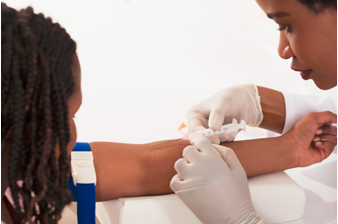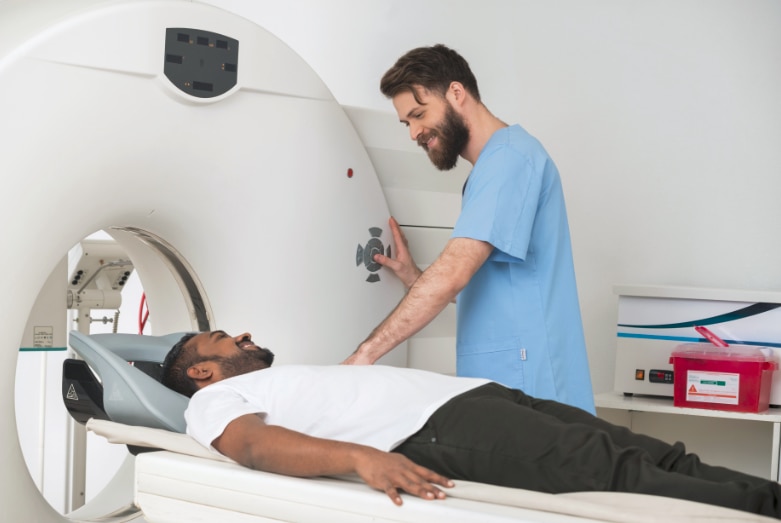Diagnosis of Adrenal Insufficiency & Addison's Disease
How do doctors diagnose adrenal insufficiency?
Your doctor will review your symptoms and run tests to confirm that your cortisol levels are low.
Review of symptoms
In its early stages, adrenal insufficiency can be hard to diagnose since symptoms come on slowly. Your health care professional may suspect it after reviewing your medical history and symptoms. The next step is blood testing to see if your cortisol levels are too low and to help find the cause.
Blood tests
ACTH stimulation test
The ACTH stimulation test is the test used most often to diagnose adrenal insufficiency. In this test, a health care professional will give you an intravenous (IV) injection of man-made ACTH, which is just like the ACTH your body makes. Your health care professional will take samples of your blood before and 30 minutes or 60 minutes after the injection. The cortisol levels in your blood samples are measured in a lab.

The normal response after an ACTH injection is a rise in blood cortisol levels. People with Addison’s disease and most people who have had secondary adrenal insufficiency for a long time have little or no increase in cortisol levels. The adrenal glands may be too damaged to respond to ACTH.
The ACTH test may not be accurate in people who have had secondary adrenal insufficiency for a shorter time because their adrenal glands have not yet shrunk and can still respond to ACTH.
Insulin tolerance test
If the results of the ACTH stimulation test aren’t clear or your doctor suspects a problem in the pituitary, you may have an insulin tolerance test (ITT). A health care professional will give you an IV injection of the hormone insulin, which lowers your levels of blood glucose. The dose is high enough to cause hypoglycemia, which occurs when your blood glucose level drops too low.
Hypoglycemia causes physical stress, which normally triggers the pituitary to make more ACTH. A health care professional will draw your blood at the beginning of the test and again every half hour during the next 2 hours. If your cortisol levels are low, your pituitary isn’t making enough ACTH, so your adrenal glands don’t make enough cortisol. The ITT is the most reliable test to diagnose secondary adrenal insufficiency.
Very low blood glucose levels can be dangerous, so a health care professional must be present at all times during this test to make sure blood glucose levels don’t drop too low. The ITT isn’t safe for people with heart disease, a history of seizures, and other serious illnesses.
CRH stimulation test
The CRH stimulation test is another option to help identify secondary insufficiency if the results of the ACTH test aren’t clear. This test can also tell secondary from tertiary adrenal insufficiency.
A health care professional will give you an IV injection of CRH and take samples of your blood before and 30, 60, 90, and 120 minutes after the injection to measure ACTH levels. If the pituitary is damaged, it won’t make ACTH in response to the CRH injection. This result shows secondary adrenal insufficiency. A slow rise in ACTH levels suggests tertiary adrenal insufficiency.
What tests do doctors use to find the cause of adrenal insufficiency?
Once doctors diagnosis and identify the type of adrenal insufficiency, they may use blood and imaging tests to find the exact cause.
Addison’s disease
Antibody blood tests
A blood test can find antibodies that are present in autoimmune Addison’s disease. Antibodies are proteins made by your immune system to protect your body from bacteria or viruses. In autoimmune Addison’s disease, the antibodies mistakenly attack the adrenal glands. Most, but not all, people with autoimmune Addison’s disease have these antibodies. If the test shows antibodies, you don’t need further testing.
Computed tomography (CT) scan
CT scans use a combination of x-rays and computer technology to create images of your organs and other internal structures. A CT scan of the abdomen can find changes in your adrenal glands. In autoimmune Addison’s disease, the glands are small or normal size and don’t have other visible abnormalities.

Enlarged adrenal glands or a buildup of calcium in the glands can occur when Addison’s disease is caused by infection, bleeding in the adrenal glands, or cancer cells in the glands. However, these changes don’t always occur in Addison’s disease caused by TB.
Tests for TB
Tests to find TB include a chest x-ray, a urine test to look for the bacteria that causes TB, and a TB skin test. In the skin test, a health care professional injects a tiny amount of inactive TB bacteria under the skin of your forearm. If you develop a hard, raised bump or swelling on your arm, you have the TB bacteria in your body, even if you don’t have active TB.
Secondary and tertiary adrenal insufficiency
Magnetic resonance imaging (MRI)
MRI machines use radio waves and magnets to create detailed pictures of your internal organs and soft tissues without using x-rays. An MRI can look for changes in your pituitary and hypothalamus, such as large, noncancerous pituitary tumors.
This content is provided as a service of the National Institute of Diabetes and Digestive and Kidney Diseases
(NIDDK), part of the National Institutes of Health. NIDDK translates and disseminates research findings to increase knowledge and understanding about health and disease among patients, health professionals, and the public. Content produced by NIDDK is carefully reviewed by NIDDK scientists and other experts.

